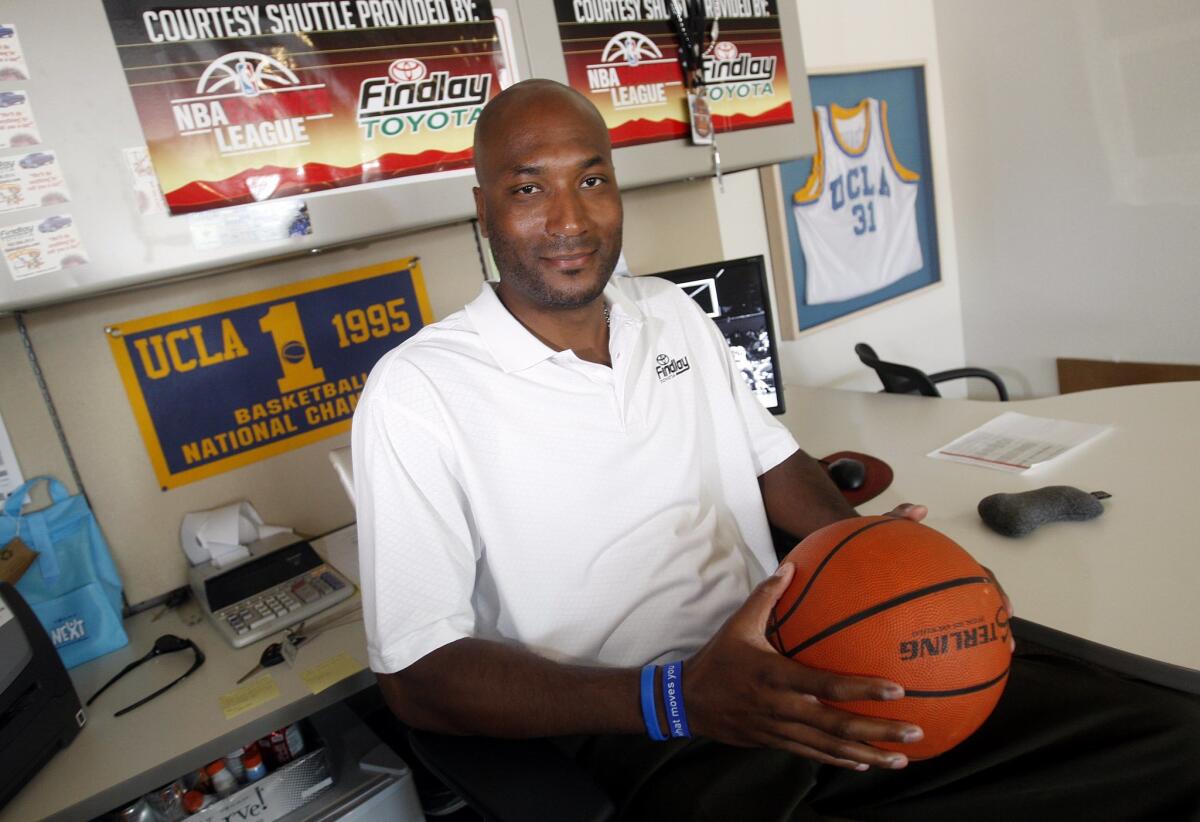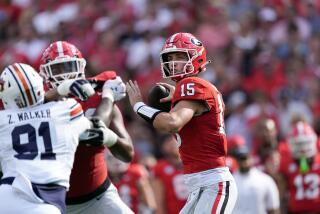Opinion: Despite court ruling, college athletes deserve a richer slice of the pie

Former UCLA basketball player Ed O’Bannon Jr. is the main plaintiff in a challenge to the NCAA’s rules barring payments to athletes, which received a mixed decision by the 9th Circuit Court of Appeals.
- Share via
This looks like a tie.
The 9th Circuit Court of Appeals today upheld a lower court’s ruling that the NCAA violated federal antitrust laws by barring colleges from offering athletic scholarships for more than the cost of tuition. But it also struck down the same judge’s decision that schools could pay athletes up to $5,000 a year to be held in trust until they left school.
So under the ruling, the student athletes can benefit from their schools’ marketing of their likenesses up to the total cost of attending the school (including travel, cellphone bills, etc.), but because some of the NCAA’s marketing appeal is built on the atmosphere of amateur competition, the NCAA can bar schools from paying athletes.
It seems a reasonable balance except for one thing – top-tier college athletics isn’t an amateur pursuit. It’s a big business built on the performances of student athletes, and they deserve a bigger slice of that rather rich pie.
The Times’ editorial board last year endorsed U.S. District Judge Claudia Wilken’s ruling that the NCAA rules unfairly restrained competition for top athletes by “effectively fixing the price student athletes could command from the most desirable schools.” But the board also liked that Wilken’s ruling still preserved the concept of amateurism in college athetics.
“Wilken’s ruling allows colleges and universities to compete for student athletes by offering more aid (up to the ‘full cost of attendance’) and a share of the fees for using their names and likenesses, payable after they leave college,” the board said. “Her injunction, which is to take effect in 2016, adds to the growing body of rulings and decisions favoring student athletes; notably, the NCAA’s board of governors agreed last week to let five major-college conferences set their own limits on aid to student athletes, potentially allowing them to cover the full cost of a college education as well as providing better health and insurance benefits. These steps give colleges the opportunity to treat athletes more fairly without turning them into professionals. The schools shouldn’t hesitate to take it.”
But the problem is that top-tier college athletics is a professional pursuit in all but name. The coaches and administrative staffs are paid competitive (and in the case of top coaches, obscene) wages. If the NCAA is going to limit the amount of benefits that go to the players – the people who do the real work – then shouldn’t it also limit the amount of money the coaches receive?
That won’t happen because coaches aren’t students and are considered professionals, so the NCAA would run into antitrust problems were it to try to limit their compensation. But because the NCAA markets itself as an overseer of amateur sports, it gets to limit the compensation of the people playing the games that people spend so much money watching. In other words, college sports management is professionalized but the people who work for them are amateurs in an entertainment industry that reaps millions from television rights and use of the players’ images in video games, among other streams.
This is the second setback for the notion that the people doing the work in college sports should get more of the proceeds. In August the National Labor Relations Board declined to exert jurisdiction over a petition by football players at Northwestern University who had won an earlier decision that they had a right to organize. The reason the NLRB punted? NCAA leagues include private schools like Northwestern, which fall under the NLRB’s jurisdiction, and public universities, which do not. To rule on the case, the NLRB said, would be to put the public universities under different rules than the private, which would not “promote stability in labor relations.”
Labor relations, not player or amateur relations. So where the NLRB tacitly recognized that the players were, in effect, workers, the 9th Circuit Court said they were not – or at least not workers deserving of proper compensation beyond an education.
This would make an interesting course for a college labor relations program. Oops, I mean amateur relations program.
Follow Scott Martelle on Twitter @smartelle.
More to Read
A cure for the common opinion
Get thought-provoking perspectives with our weekly newsletter.
You may occasionally receive promotional content from the Los Angeles Times.











